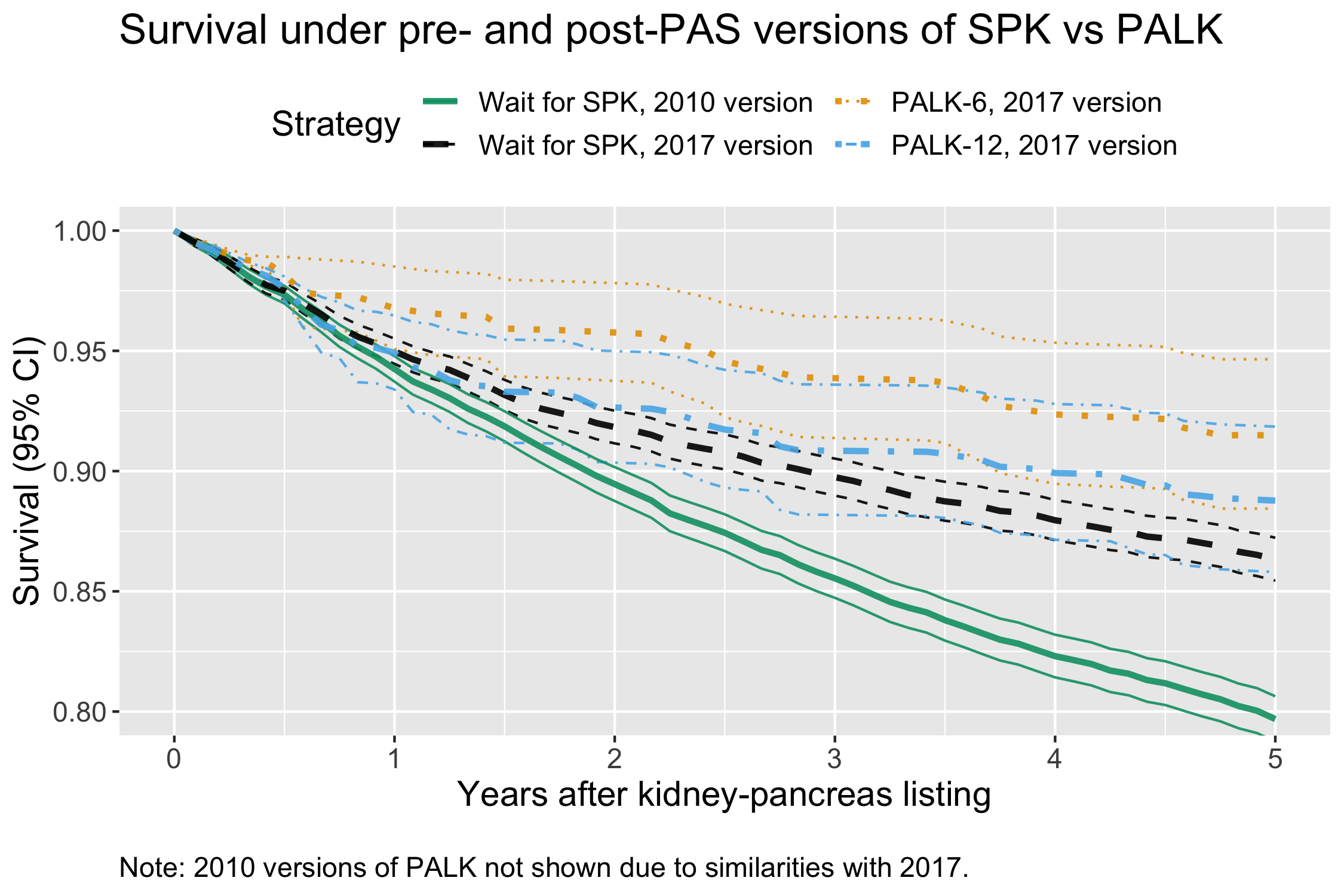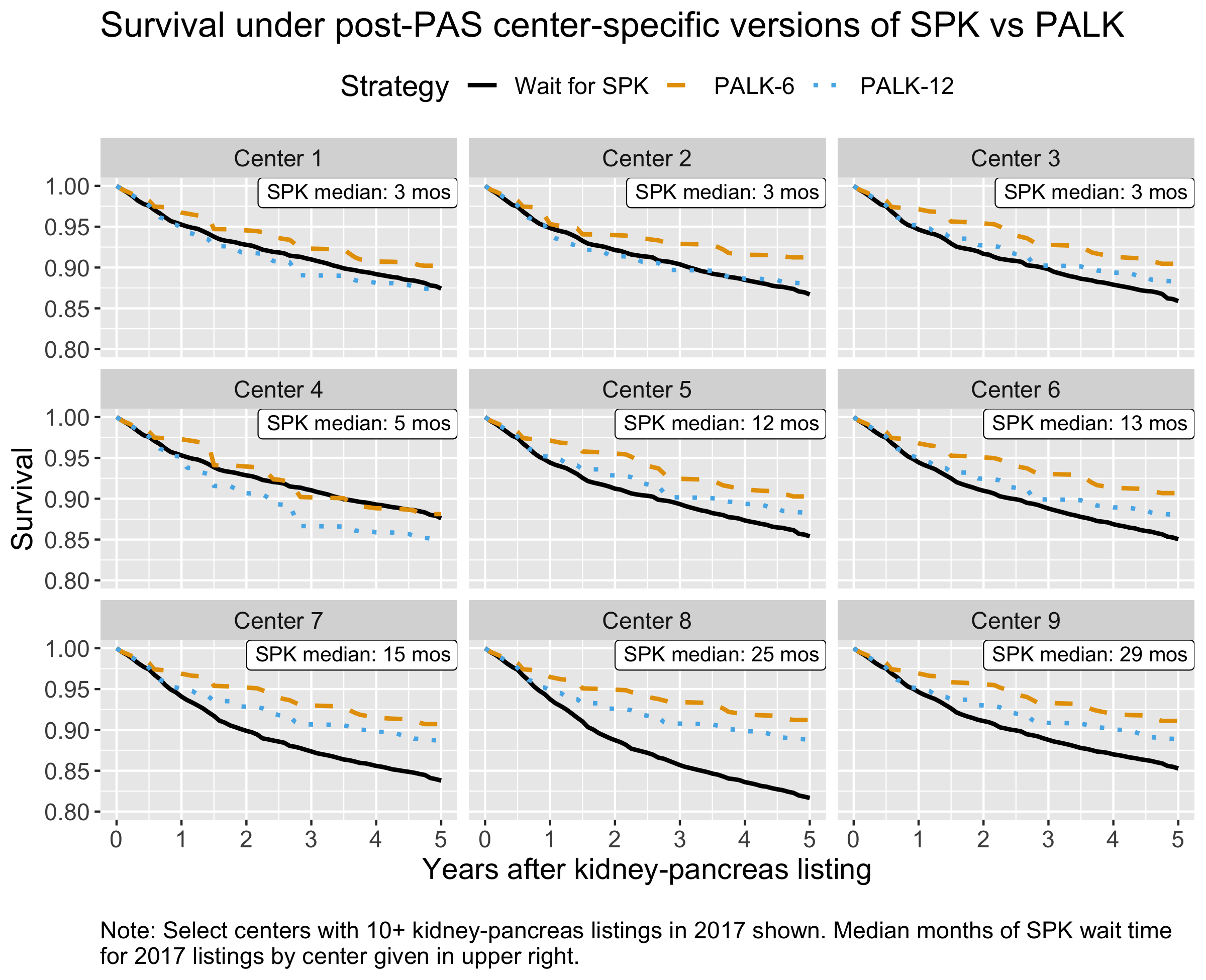Survival Comparison of Simultaneous Pancreas-Kidney Transplant with Pancreas After Living-Donor Kidney Transplant by Wait Time and Organ Quality
1Scientific Registry of Transplant Recipients, Hennepin Healthcare Research Institute
Division of Biostatistics, University of Minnesota, Mpls, MN, 2Div Biostatistics U MN, Mpls, MN, 3Dept Surg U MN, Mpls, MN, 4Hennepin Healthcare Research Institute, Mpls, MN
Meeting: 2022 American Transplant Congress
Abstract number: 1147
Keywords: Allocation, Kidney/pancreas transplantation, Survival, Waiting lists
Topic: Clinical Science » Pancreas » 65 - Pancreas and Islet: All Topics
Session Information
Session Name: Pancreas and Islet: All Topics
Session Type: Poster Abstract
Date: Sunday, June 5, 2022
Session Time: 7:00pm-8:00pm
 Presentation Time: 7:00pm-8:00pm
Presentation Time: 7:00pm-8:00pm
Location: Hynes Halls C & D
*Purpose: The survival benefit of simultaneous pancreas-kidney (SPK) compared to pancreas after living-donor kidney (PALK) transplant is controversial. Wait times for SPK and donor risk indices vary widely by center and have decreased since the introduction of the 2014 pancreas allocation system (PAS). We sought to characterize how differences in wait time and organ quality affect survival for patients waiting for SPK relative to patients who pursue PALK.
*Methods: Using 2001-2019 SRTR kidney-pancreas listing data (N=10,335; ages 18-60), we estimated post-listing patient survival by inverse probability (IP) weighted Kaplan-Meier for two strategies: 1) Wait for SPK and 2) Get living-donor kidney transplant within 6 or 12 months, then list for pancreas alone (PALK-6; PALK-12, respectively). Survival was estimated for different transplant rates and organ quality distributions as experienced in different centers and eras (2010/pre-PAS vs 2017/post-PAS). The endpoint was death or removal due to deteriorated condition. IP weights adjusted for standard confounders.
*Results: Averaged across centers, 5-yr survival for pre-PAS SPK was 80% (95% CI 79-81%), which was significantly lower (p<0.001) than 5-yr survival for PALK-6, 91% (88-94%), or PALK-12, 88% (85-92%). Post-PAS, when median SPK wait time decreased from 13 to 7 mos, 5-yr survival for SPK was 86% (85-87%), which was lower than PALK-6, 91% (88-95%) (p=0.01), but comparable to PALK-12, 89% (86-92%) (p=0.16) (Figure 1). Survival varied by center post-PAS, including several centers where waiting for SPK was estimated to outperform PALK, due primarily to shorter-than-average SPK wait times at these centers (Figure 2).
*Conclusions: Survival differences between SPK and PALK strategies depend on the rate of SPK transplant. Under the new PAS, survival may be comparable for some patients whether they wait for SPK or pursue a living-donor transplant within the year, indicating some potential living donors could be spared the risk of donation.
To cite this abstract in AMA style:
Lyden GR, Helgeson ES, Finger EB, Matas AJ, Snyder JJ, Vock DM. Survival Comparison of Simultaneous Pancreas-Kidney Transplant with Pancreas After Living-Donor Kidney Transplant by Wait Time and Organ Quality [abstract]. Am J Transplant. 2022; 22 (suppl 3). https://atcmeetingabstracts.com/abstract/survival-comparison-of-simultaneous-pancreas-kidney-transplant-with-pancreas-after-living-donor-kidney-transplant-by-wait-time-and-organ-quality/. Accessed December 21, 2025.« Back to 2022 American Transplant Congress


